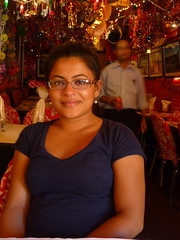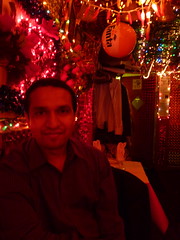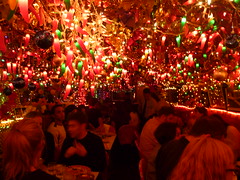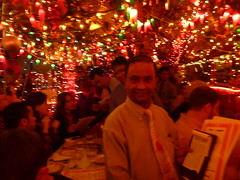 Hannah Rubenstein Boshir Khan, of Panna II, and Thahmina Ahmed, of Milon, are continuing a restaurant rivalry that has lasted more than 20 years.
Hannah Rubenstein Boshir Khan, of Panna II, and Thahmina Ahmed, of Milon, are continuing a restaurant rivalry that has lasted more than 20 years.Boshir Khan leans over the plastic tablecloth at Panna II, glancing around the crowded restaurant to ensure that no one is listening. His voice is conspiratorial, nearly inaudible beneath the blaring Bollywood trills and ululations that emanate from speakers overhead. “I am launching a new website,” he says confidingly. When asked for more details, Mr. Khan will only smile mysteriously. “It will be completely new,” he replies. “Go and see.”
He will say no more for fear that his latest business innovation will be usurped by the enemy, Milon, a rival restaurant which shares the same building at First Avenue and Sixth Street. A silent, dazzling and well-chronicled war has raged between these two Indian eateries in the East Village for more than two decades.
Now, a new generation of owners is preparing to take this battle for the hearts and stomachs of diners to a new level online. Any day now, Mr. Khan will launch a revamped website and he promises that its features will assure Panna II of its culinary supremacy once and for all.
For now, though, Mr. Khan offers few details and each evening as the sun sets, the battle begins anew, bathing the sidewalk in a neon blaze.
Milon and Panna II are mirror images of one another. They share many similarities: menus, BYOB policy, prices, décor—and a home. Flanking opposite sides of an iron staircase, each restaurant consists of one corridor-like dining room where tables and chairs form a labyrinthine obstacle course for waiters. Bollywood music is pumped through the restaurants at a deafening volume. A disco ball hangs from the ceiling.
And then there are the lights.
Both restaurants—and, to a lesser extent, the newer Royal Bangladesh that occupies the building’s ground floor—are filled with thousands of blinking, glittering, flashing strands of lights that hang low enough so that patrons are unable to stand upright. Strands of Christmas lights, red chili peppers, tinsel, plastic flowers—the entire space is a claustrophobic holiday melee. As Judy Mann, a customer waiting outside in line for a table at Milon, remarked, “Dining here is a unique experience of eating in cramped quarters inside a Christmas tree.”
These Curry Row eateries may look identical to passersby—indeed, a conspiratorial theory among long-time East Village residents is that the restaurants share one kitchen —but the relationship between the establishments is anything but harmonious. In fact, there is no relationship to speak of—Milon and Panna II have been embroiled in a rivalry for over 20 years that has no end in sight.
The central conflict between the two restaurants stems from a dispute over authenticity. Although neither family-owned business denies that Milon was established first (in 1982, preceding Panna II in 1988), the question of innovation has become the basis for a rivalry that has been passed down from one generation to the next. And now, with Mr. Khan venturing into cyberspace before his rival, the bar has been raised.
The feud can be summed up with one simple question: who came up with the idea for the lights?
 Hannah Rubenstein At the heart of the dispute is the question of which restaurant first used lights as decorations: Milon (top) or Panna II.
Hannah Rubenstein At the heart of the dispute is the question of which restaurant first used lights as decorations: Milon (top) or Panna II.Each side claims the origin story as its own. Thahmina Ahmed, the daughter of Milon founder Olid Ahmed, is running the restaurant while her father is away for several months. A 28-year-old nursing student at Long Island University, Ms. Ahmed is thoughtful and composed, ending each sentence with a slight smile.
She says the genesis of the lights, was a gimmick invented by her father to lure customers during a business slump in the early 1990s. As Mr. Ahmed told The Times in 1999, “It is a traditional decoration.” Her father, Ms. Ahmed says, wanted to “reinvent the place,” and began by pasting plastic flowers “from top to bottom, on the windows, everything.”
Customers were drawn in from the street, Ms. Ahmed says, and her father began to add other decorations, like the chili peppers. “It’s a nod to the fact that Indian people like spicy food,” she explains.
Next door, Mr. Khan, who took over the business from his father Fazid in 2001 after earning his MBA from NYU, tells a different tale. According to Mr. Khan, during the winter of 1988, his father decided to hang strands of blinking Christmas lights, tinsel, and a few small plastic flowers to add holiday cheer. The lights weren’t taken down immediately after the holidays, and customers coming in February, Mr. Khan says, enjoyed the festive touch. The chili pepper lights—identical to those hanging in Milon’s dining room—were inspired by some he saw in a Mexican restaurant in Midtown one night.
“Next door copied our lights,” he states unequivocally. And their claim that they were the innovators? “A complete lie, 100 percent,” says Mr. Khan. To guard against imitation, his newest business investment, a revamped website, is spoke of in a whisper, accompanied by wary glances.
In addition to claiming originality for the décor, both restaurants insist that the continued existence of their neighbor is based solely on their own success in attracting customers to the restaurant by offering delicious, affordable food in a unique environment. Indicating the restaurant next door, Mr. Khan states it bluntly: “When we came here in 1988, that place was a trashcan.”
In 1988, Mr. Khan was 15 years old. Thahmina was only six. But the animosity between their fathers is a birthright, inherited along with the ever-growing collection of twinkling lights.
 Hannah Rubenstein On an average weekend night, two lines curl out of the restaurants’ doors: one to Milon (top) the other to Panna II.
Hannah Rubenstein On an average weekend night, two lines curl out of the restaurants’ doors: one to Milon (top) the other to Panna II.The Hatfield/McCoy-like rivalry has become a legacy that long-time customers of the restaurants ascribe to without reservation. Each establishment claims that the majority of its business comes from unflinchingly loyal customers. On an average weekend night, two lines curl out of the restaurants’ doors, down the stairs, and across the sidewalk: one for Milon, the other for Panna II.
Erica and Jeff Whalen commute from Westchester with their 4-year-old son, George, just to eat at Panna II. Sitting near the window, the family shines alternately red and green as the lights flicker overhead. Customers of the restaurant for more than 18 years, the Whalens are steadfast in their loyalty: “The food is perfectly portioned, affordable, and flavorful,” Mrs. Whalen says. Had they ever been to Milon? “Once.” What were their thoughts? “It’s O.K., but it’s not as good,” Mr. Whalen explained. “It’s not the same.”
Likewise, Milon has clientele who “no matter what is offered next door, will say ‘no, we’re going to Milon,’” Ms. Ahmed says. Having been born the same year as the restaurant opened, she will often see customers who tell her that they remember her as a baby in a stroller. Why does she believe that they keep coming back, year after year?
“It’s the original,” she says simply.
Milon does not currently have a home on the internet. But Panna II does. The soon-to-be-relaunched site has moved the endless war into a new sphere, screaming its origin story in black letters against a red background.
The site offers its own take on Mr. Khan’s use of the lights: “He decided to go loco with Christmas lights, Red-hot chilli pepper lights & all the paper decorations and this worked because it was original, NO ONE in Little Bengal had such an ambiance.
“So, don’t accept imitation when you can have the original.”






